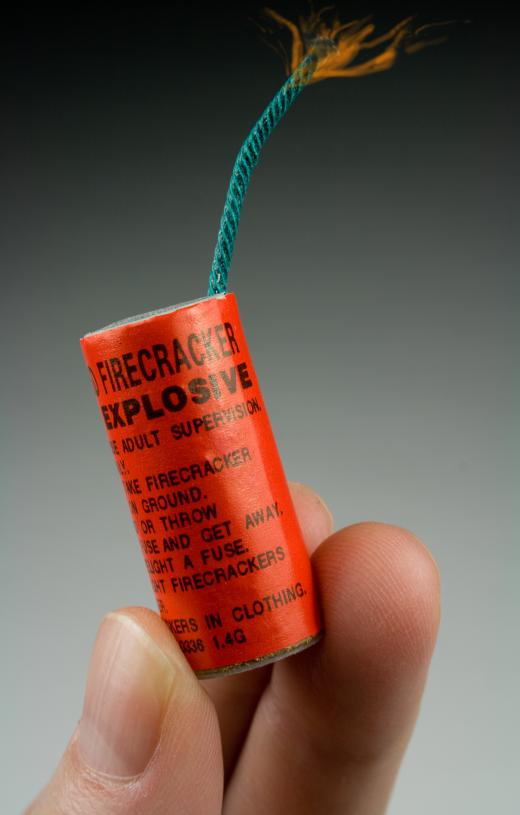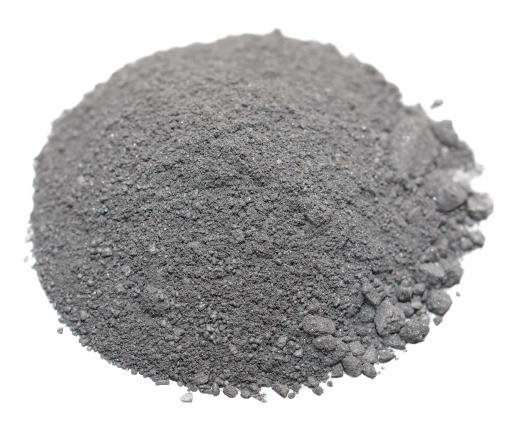How does a Firecracker Work?
 Michael Pollick
Michael Pollick
A firecracker is perhaps one of the first fireworks a young would-be pyrotechnician learns to handle. It consists of a small cardboard tube wrapped in decorative paper, with a wick-like fuse extending from one end. The idea is to put it on the ground, light the wick, and then stand back. Within a few seconds, there should be a flash of light and a loud bang. If an entire string of firecrackers is lit, the result is a series of small explosions and a generous supply of smoke and fire.
So how do these things actually work? The answer lies in the nature of the chemicals packed inside the tube and the pressure they create once they begin to burn. A typical firecracker contains a small amount of black powder or gun powder, which burns rapidly when it comes in contact with an open flame, such as the chemically impregnated paper wick.

Black powder consists of three ingredients: potassium nitrate, charcoal (or sugar), and sulfur. A typical ratio of these three ingredients would be 75% potassium nitrate, 15% charcoal or sugar, and 10% sulfur. Each one of these chemicals plays an important role in the reaction started when a flame reaches the charcoal and starts a fire.
Inside a cardboard tube, the tightly packed black powder generally remains stable until the fuse is lit. When the fuse burns down into the tube, the charcoal ignites first. The sulfur interacts with the carbon in the burning charcoal and starts to create gases. The potassium nitrate acts as an oxidizer, essentially adding more oxygen to the mix and making the fire even hotter. The gases continue to expand, but they have nowhere to vent in the firecracker tube.

Finally, the pressure from the gases becomes too great for the tube and it bursts apart, creating the loud popping sound associated with fireworks. The burning black powder also becomes visible, causing a brief flash of light and a plume of black smoke. The firecracker itself becomes light enough to be carried off by the wind, which is why there is often no trace of the firework after ignition.

International laws concerning fireworks control how much black powder a fireworks manufacturer can put in an individual firecracker. The small ones used during Chinese New Year or July 4th celebrations do not generally contain much black powder, but certain illegal firecrackers may contain levels approaching that of commercial dynamite. Several fireworks manufacturers do sell larger versions that allegedly contain the highest amount of black powder allowed by law, but actual results may vary.
As with any other pyrotechnic device, a firecracker should only be lit under controlled conditions and should never be modified before use. Even a small one can cause serious damage to a user's body or property if not used as intended. It should also never be lit during drought conditions or in cities where Class C fireworks are considered illegal.
AS FEATURED ON:
AS FEATURED ON:













Discussion Comments
It amazes me how much misinformation circulates regarding modern firecrackers sold in the US.
All current firecrackers, regardless of physical size, are limited to 50 milligrams of explosive powder in the US. That's about half the size of an aspirin. Not much explosive power. Yes, a firecracker is a small "bomb". The definition of bomb is a vessel that contains high pressure for a period of time. By that definition, a bottle of pop is a "bomb".
@irontoenail - There's a lot of countries that have basically banned personal fireworks, including firecrackers for just that reason. Too many people, especially kids, hurting themselves by acting foolish, and too many unplanned fires.
I know that the fire brigade must absolutely hate July 4th, which is a shame because they should be able to enjoy it along with everyone else.
I don't know, I get it that people like being able to have their own display, but the public displays are always better anyway. I have to admit I'm in favor of a ban.
@umbra21 - As it says in the article, there are obviously times when they put too much explosive powder into the firecrackers and they could be dangerous (or more dangerous than usual).
One of my most vivid memories of childhood is letting off some fireworks at my uncle's place in Colorado for Independence Day. He lived up in some undeveloped hills and there was a lot of dry brush around. Well, you can guess what happened. A small fire started, either from one of our fireworks or someone else's and my father and uncle had to climb up into the hills in order to try and put it out.
When you think about how out-of-control wildfires can get, and that July 4th is in the middle of summer, it's amazing that the entire country hasn't burned down.
@anon9421 - I believe firecrackers are considered to be explosives by the US government and are classified according to their strength. While the kinds of fireworks you get at the store aren't really comparable to bombs, the ones that are used for public displays are often quite powerful and could potentially be used in nefarious ways. However, I'm not sure that any firecrackers fall into the highest category of explosives. Maybe their component parts would if they were in bigger quantities.
They also have a fairly complex shipping code for transporting firecrackers and other kinds of explosives, but I'm not sure how that works exactly.
i have a question? is a firecracker considered a bomb (although inconsequential compared to TNT or C-4). and under what federal laws do they fall under.
The white smoke indicates flash powder. Black would be from the older (or a homemade job?) gunpowder.
they typically use flash powder and not black powder as the bursting charge. flash powder burns at a much higher rate. it is made of an oxidizer(potassium percholate) and a fuel(powdered aluminum). old style crackers did use black powder but that is not a common practice anymore.
sometimes white smoke appears after burning of firecracker, not black.
Post your comments